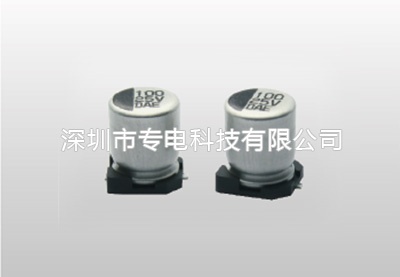one,Aluminum electrolytic capacitor concept
Aluminum electrolytic capacitors are made of an aluminum cylinder as the negative electrode, with a liquid electrolyte inside, and a curved aluminum strip inserted as the positive electrode. It also needs to be processed by DC voltage to form an oxide film on the positive electrode sheet as a medium. It is characterized by large capacity, but large leakage, poor stability, positive and negative polarity, and is suitable for use in power supply filtering or low-frequency circuits.
2. Common failure modes of aluminum electrolytic capacitors
Capacitors sometimes fail, and the materials, structures, manufacturing processes, performance and operating environments of various types of capacitors are different, and the failure mechanisms are also different. Today we will reveal the common failure modes of aluminum electrolytic capacitors: leakage, explosion, open circuit, breakdown, deterioration of electrical parameters, etc.
3. Analysis of failure forms and causes
1. Liquid leakage
Liquid leakage is one of the reasons for capacitor failure, and aluminum electrolytic capacitors are no exception. The working electrolyte of aluminum electrolytic capacitors is acidic. If it overflows, it will seriously pollute and corrode other components and printed circuit boards around the capacitor. At the same time, inside the electrolytic capacitor, the working electrolyte gradually dries up due to leakage, and the ability to repair the anodized film dielectric is lost, resulting in capacitor breakdown or deterioration in electrical parameters and failure.
There are many reasons for leakage, such as:
①The aluminum electrolytic capacitor is not properly sealed;
② If a rubber plug is used to seal the aluminum electrolytic capacitor, the rubber may age and crack due to long use, causing leakage;
③There are problems with the mechanical sealing process;
④ Installation issues. Generally, manufacturers will consider the problem of leakage. They will clearly stipulate in the company standards that vertical installation is required, while some companies choose horizontal installation.

2. Explosion
The AC component of the working voltage of the aluminum electrolytic capacitor is too large, or the oxide film medium has many defects, or there are harmful anions such as chlorine and sulfate, resulting in the electrolysis effect generating gas at a faster rate when the leakage current is larger, and the operation The longer the time, the greater the leakage current, the more gas in the shell, and the higher the temperature. The air pressure difference inside and outside the capacitor's metal shell will increase with the increase of operating voltage and operating time. If the seal is good and there is no explosion-proof method, the air pressure will increase to a certain extent and cause the capacitor to explode.
At present, explosion-proof shell structures have been widely used. A pleat is added to the upper part of the metal shell. When the air pressure is high, the pleat is pushed open to increase the volume inside the shell, thereby reducing the air pressure and reducing the risk of explosion. In use, such as applying overload voltage, rapidly charging and discharging the capacitor, applying reverse voltage, etc., may cause the capacitor to explode.
3. Breakdown
The breakdown of aluminum electrolytic capacitors is caused by the rupture of the anodized aluminum dielectric film, causing the electrolyte to come into direct contact with the anode. The aluminum oxide film may be locally damaged due to various materials, process or environmental conditions. Under the effect of an external electric field, the oxygen ions provided by the working electrolyte can re-form an oxide film at the damaged area, allowing the anodic oxide film to be filled and repaired. However, if there are impurity ions or other defects in the damaged area, which prevents the filling and repair work from being completed, micropores will be left on the anodized film, which may even become penetration holes, causing the aluminum electrolytic capacitor to break down.
In addition, with the increase of use and storage time, the solvent in the electrolyte is gradually consumed and evaporated, causing the acid value of the solution to rise and causing corrosion to the oxide film during storage. At the same time, due to the aging and drying up of the electrolyte, it is no longer able to provide oxygen ions to repair the oxide film under the effect of the electric field, thereby losing the self-healing effect. Once the oxide film is damaged, the capacitor will breakdown.
Process shortcomings are also a major cause of breakdown of aluminum electrolytic capacitors. For example, if the riveting process is not good, the hair on the foil strip will severely damage the oxide film, causing a large leakage current in the punctured area, and local overheating will cause thermal breakdown of the capacitor. Over-temperature, over-ripple current or over-mechanical stress during use may cause capacitor breakdown and failure.
4. burn
Burning of aluminum electrolytic capacitors is generally caused by the following reasons:
①The positive and negative poles are connected reversely
Aluminum electrolytic capacitor is a capacitor with positive and negative poles. If the positive and negative poles are connected incorrectly when installing an aluminum electrolytic capacitor, the capacitor will burn out;
②Insufficient pressure resistance
When the voltage exceeds the withstand voltage value of the aluminum electrolytic capacitor, the capacitor will also burn out;
③Unqualified quality
The aluminum electrolytic capacitors produced by some manufacturers are substandard, which may also cause the burning of the capacitor.
5. Open the way
Aluminum electrolytic capacitors may suffer open-circuit failure when operating in high temperature or hot and humid environments for a long time. The reason is that the anode lead foil is broken due to electrochemical corrosion. Regarding high-voltage large-capacity capacitors, there are many such failure modes.
In addition, if the anode lead-out foil and the anode foil are not fully leveled after riveting, poor contact will cause intermittent open circuits in the capacitor. In use, excessive mechanical stress may cause the capacitor to open circuit.
6. Deterioration of electrical parameters
① Capacity decrease and loss increase
The capacitance of aluminum electrolytic capacitors decreases slowly in the early stages of operation. This is caused by the continuous repair and thickening of the anodized film by the operating electrolyte during the load process.
In the later stages of use of aluminum electrolytic capacitors, due to the greater loss of electrolyte and thickening of the solution, the resistivity increases due to the increase in viscosity, which increases the equivalent series resistance of the working electrolyte, resulting in a significant increase in capacitor loss. At the same time, the electrolyte with increased viscosity is difficult to fully contact the oxide film layer on the surface of the corrugated and uneven aluminum foil, which reduces the effective area of the plate of the aluminum electrolytic capacitor, causing a sharp decrease in capacitance. This is also a sign that the service life of the capacitor is nearing the end.
In addition, if the viscosity of the working electrolyte increases too much at low temperatures, it will also cause increased losses and a sharp decrease in capacitance. In use, over-temperature and over-ripple current may cause the capacitance to decrease and the loss to increase.
②Leakage current addition
Increased leakage current often causes aluminum electrolytic capacitors to fail. The process level is low, the oxide film is seriously damaged and contaminated, the working electrolyte formula is poor, the purity of the raw materials is not high, the chemical and electrochemical properties of the electrolyte are difficult to stabilize for a long time, the purity of the aluminum foil is not high, and the impurity content is high, etc. These factors are all factors. It may cause excessive leakage current failure. Chloride ion contamination in aluminum electrolytic capacitors is serious, and leakage current causes the oxide film to decompose in the contaminated area, causing perforations, which further increases the current.
In short, the presence of metal impurities in aluminum foil will increase the leakage current of aluminum electrolytic capacitors , thereby shortening the life of the capacitor. Overvoltage during use may increase the leakage current of the capacitor.




